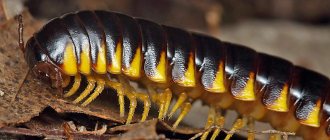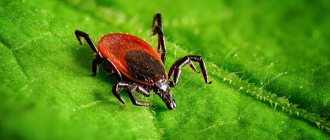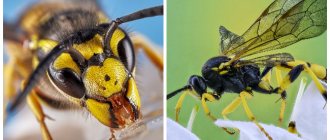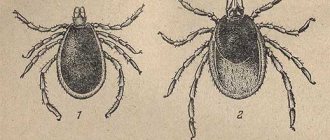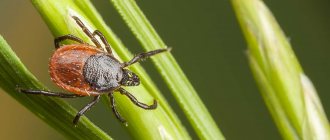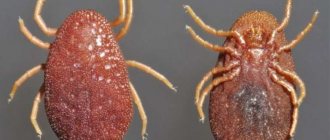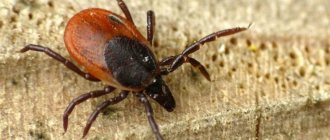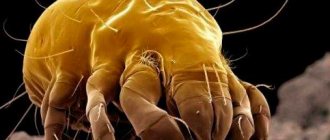Argasid mites belong to the subfamily of iscoid mites and are divided into two types: ornithodorines and argasines. Their popular name sounds like soft or lying in wait ticks. They earned such nicknames due to their body structure and their tendency to settle in secluded places, such as burrows, crevices and cracks, as well as nests and grottoes. Representatives of some species can live in various outbuildings; there are also those that are found in the cracks of rooms whose walls are made of clay.
Appearance, varieties and features
Argasid mites are the largest representatives of the family. Their length reaches 3 cm. They have a flat oval body with folds and without a shell, soft in appearance. Because of this, they are also called soft ticks. The mouthparts with sharp jaws and proboscis are located below. The tick has 4 pairs of limbs, on which it moves rather slowly.
Females are noticeably larger than males. The color of an individual depends on whether it has drunk blood or not. When hungry, argasid mites are gray in color with a noticeable border around the circumference. When the tick has drunk blood, it swells and becomes purple-purple in color. An adult can absorb 12 times more blood than its own weight.
In its development, a tick goes through the following stages:
- egg;
- larva;
- nymph of the first, second, third age;
- imago - an adult individual.
The female lays about a hundred eggs. Under unfavorable conditions, there may be more nymph stages. Typically, the process of turning an egg into an adult takes about a year, in poor conditions - up to two years. Argasid mites are parasitic starting from the larval stage.
Peculiarities
Argasid mites live up to 20 years, and can live for a very long time without food. Thus, an adult can survive without food for up to 14 years, and a larva can live in this state for up to 2 years.
Kinds
Argasid ticks are divided according to the blood of which animals and birds they prefer to feed on. For example, there are ticks that feed on blood:
- large and small cattle (Alveonasus lahorensis and Alectorobius Тholozani);
- chickens (A. Persicue);
- dogs and goats (Alect. Asperus);
- pigeons (Alect. Coniceps).
There are species that feed on the blood of various animals, including small rodents.
12 species of argasid mites (Argas and Ornithodoros) can attack humans.
Village ticks are considered the most dangerous. They can parasitize any vertebrate animals and humans.
Scabies is an intradermal parasite
Such mites provoke the development of acarodermatitis. They live under the skin, which means they are not giant pests.
However, compared to many microscopic parasites, such individuals are superior in length. Thus, the average body size of ticks is up to 0.5 mm. They have 8 limbs, like other arthropods. The body shape is round. Egg size is no more than 0.14 mm. Moreover, the female lays her offspring under the skin, and reproduction occurs on the surface of the outer integument.
Parasites live in the structure of the human epidermis and are attracted to blood. Grooves remain on the skin. They can most often be seen on the back of the limbs, in the armpits, between the fingers, and in the groin. Scabies is a species of the family of the same name, the order Sarcoptiform mites (superorder - Acariform mites, discussed above).
Suckers on the front legs are clearly visible
The process of laying eggs in the “passages” of human skin
Harm from the argas mite to humans
Argas mites attack livestock and poultry, causing their death. They also carry dangerous diseases.
A tick bite hurts. The bite site turns red and itches. Allergic reactions occur because when a tick bites, it injects saliva that has a toxic effect. A papule filled with bloody fluid forms at the site of the bite.
A person can become infected after a tick bite with the following diseases:
- borreliosis;
- relapsing fever;
- hemorrhagic fever.
These diseases are the most common, but argas ticks can also carry other infections. If you find a tick or bite, you should consult a doctor as soon as possible and begin treatment.
Argasid mites attack people in the absence of other food, so there are not many cases of disease infection from this type of mite in humans. They pose a much greater danger to animals.
Ticks in the house or “cat stories”
Even if the cat has never left the apartment, it can be attacked by an Ixodid tick brought in from the street or attached to your dog. Comb Murka's fur with a fine-toothed comb and blow on it. If you find a fast-moving tick, remove it, burn it or dip it in alcohol. A tick that is sucking blood on the thighs, behind the ears, in the groin, on the stomach of your cat will look like a pea or a dark or pink bead. A tick bite in cats can cause the same piroplasmosis with typical signs or infectious anemia, as well as theileriosis. Worsening of the general condition, loss of appetite, inactivity, yellowing of the sclera, possible change in the color of urine, and cough should alert you.
It is necessary to remove the tick so that the head does not remain under the skin.
Danger to animals
The danger to livestock and poultry from tick bites is much higher. Tick attacks can be widespread and cause entire epidemics. Animals develop fever and even paralysis.
Symptoms of infection in pets:
- excitation;
- constant itching;
- slight trembling throughout the body;
- increased heart rate;
- dilated pupils;
- increased salivation and foaming at the mouth.
If no treatment measures are taken, the animal dies within 2 to 4 weeks.
Most often ticks attack in winter. At this time, the mite larvae emerging from the eggs become active and begin the feeding process.
Tularemia therapy
A person is very susceptible to this infection; almost everyone infected begins to get sick. The disease can occur in various forms and cause complications, such as meningitis, arthritis, meningoencephalitis, and inflammation of the heart sac.
Treatment of tularemia is carried out only in a hospital infectious diseases department. Broad-spectrum antibacterial drugs are prescribed. If they do not help, then second-line antibiotics are used. To get rid of intoxication from the body, detoxification therapy is used. The patient is discharged only after his complete recovery.
Fighting methods
Argasid mites are also called ticks in waiting. They hide in secluded places - various crevices, small cracks, holes, where they wait for their prey. To protect animals and birds from pests, it is necessary to promptly treat the premises where they are kept. Moreover, all surfaces must be carefully treated, including cracks and crevices in the floor, walls, and ceiling. For treatment, it is necessary to use products with insectoacaricidal and disinfectant effects based on benzophosphate, chlorophos, and aerol. Before treatment, animals are removed from the room; after treatment, the room must be ventilated. The livestock is treated with acaricidal agents approved for use on animals. If there are already pests on the body, then they must be removed.
Birds and their habitats are treated with dust. It is necessary to treat the poultry house, perches, and surrounding area. It is imperative to eliminate potential tick habitats - cover all cracks and cracks.
To treat livestock, poultry and premises for keeping them, you can use cypermethrin-based anti-ectoparasites, for example, Ectomethrin from MediLis. They can also be used on dogs.
Gamazovye
The chicken mite is very small, its body is less than a millimeter long, but its saliva is extremely toxic. After being saturated with blood, the female lays about 20 eggs in secluded depressions or crevices. Three days later, offspring appear, which need a host - a bird - for nutrition and further development. The chicken mite feeds only at night and goes into hiding during the day. Thus, its development, under favorable conditions, does not exceed a week.
In many ways, the life cycle depends on individual conditions and habitat. The growth in the number of argas mite individuals is facilitated by the required amount of food and high humidity levels.
It is in these conditions that a comfortable environment for the reproduction of insects is created. If they are inaccessible to the agras mite, the individual will increase, but the reproduction rate will decrease.
Nymphs can have from two to seven developmental stages. If the insect develops in suitable conditions, the life cycle occurs over several months. But if the tick cannot find the ideal environment for development, it can only survive for a few years.
Egg laying and molting occur naturally after detachment from the host. Many species of argasids lay eggs several times, and hunting occurs before each laying. After about a month, larvae emerge from the eggs, and within 30 days they can independently attack animals.
Prevention
If the farm is located in a potentially dangerous area where argasid mites are found, periodic preventive treatment of the surrounding area and premises is required. It is believed that pests move into shelters with the onset of cold weather. It is at this time that inspection of such places will be effective.
Prevention is as follows:
- cleaning the area from debris in which ticks may be hiding;
- control of rodents that can be carriers of ticks and their larvae;
- sealing cracks in buildings and structures, treating them with acaricides;
- spraying bushes and trees located next to animal and poultry premises with hexachlorane;
- a careful inspection of the territory, buildings and animals to detect ticks - they are large enough, they can be seen without special devices.
All processing must be carried out in protective clothing and in compliance with safety precautions. After treatment, thorough ventilation of the premises is necessary.
To protect yourself from tick attacks, a person needs to use repellents, for example, MediLis-Comfort.
Literature
- Balashov Yu. S.
Blood-sucking ticks (Ixodoidea) are carriers of human and animal diseases. - L.: Nauka, 1967. - 320 p. - Filippova N. A.
Argas mites (Argasidae) // Fauna of the USSR: Arachnids. - M., 1966. - T. 4. Issue. 3. - 255 p. - Tarasov V.V.
Ecology of blood-sucking insects and ticks. - M.: Moscow State University Publishing House, 1988. - 264 p. — 1400 copies.
In foreign languages
- Hoogstraal, H. (1985). Argasid and nuttalliellid ticks as parasites and vectors. Advances in Parasitology, 24, 135–238.
- Keirans, J. E. (1992). Systematics of the Ixodida (Argasidae, Ixodidae, Nuttalliellidae): an overview and some problems. In: Fivaz, B., Petney, T., Horak, I. (Eds.) Tick vector biology. Medical and veterinary aspects. Springer-Verlag, pp. 1-21.
